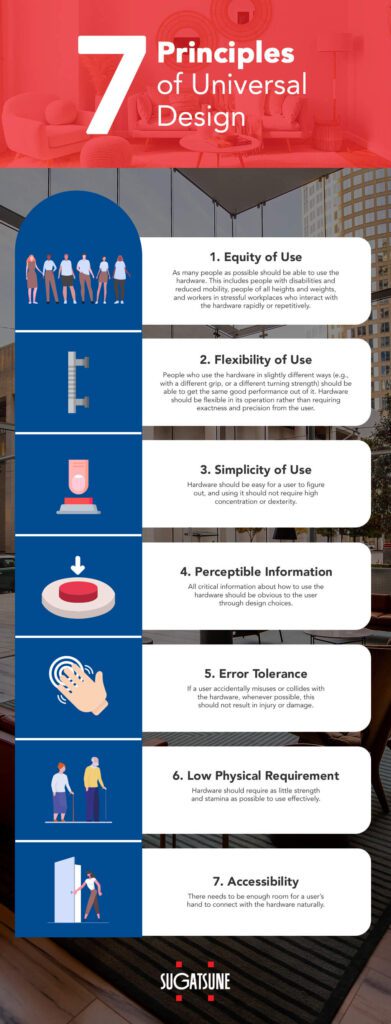How We Apply Universal Design: Interior Design for Everybody
Posted On Jun 22nd 2023
Posted On Jun 22nd 2023
Posted On Jun 22nd 2023
At Sugatsune America, one of our most important priorities is something called Universal Design. You’re probably more familiar with our other top priorities: our commitment to superior performance, quality, and durability in our hardware. But what good is excellent hardware if everyone is not able to physically use it?
Universal Design is about reducing stress and improving convenience and usability for the end users of our hardware by promoting universal accessibility—or as close to universal accessibility as we can reasonably get. In Universal Design, furniture components and hardware are designed, built, and arranged to minimize barriers to access. It is a way of thinking about design that is inclusive of the elderly, the very young, and those who are disabled or differently abled. Universal Design also helps people who are at risk of repetitive stress injuries or who are simply too busy in their workplace for the hardware they use to be anything less than fast and simple to use.
Today in the Sugatsune Hardware Blog, we’re going to look at Universal Design from an interior design standpoint. If you’re an architect, project manager, etc., who is developing or renovating properties, Universal Design can help you add value to your project by making it more useful to more people.
In Universal Design, furniture components and hardware are built to be usable by as many people as possible. We must be mindful of people’s different physical capabilities, for whom something like a traditional door knob or a latch may not be usable.
This is especially important in places like multigenerational homes with elderly individuals who are aging in place and in places like fast-paced restaurant kitchens, where good hardware design minimizes hazards and maximizes throughputs.
Here are seven key concepts in Universal Design interior design.

Universal Design Guide |
Designing for All |
Universal Design Webinar |
| This information page covers the key principles surrounding Universal Design as an architectural philosophy. | This is our e-book pamphlet with a full mission statement of why we value Universal Design and how we utilize it in our hardware. | Watch our half-hour YouTube presentation on Universal Design and see how Sugatsune’s hardware rises to the challenge. |
At Sugatsune, we design much of our hardware within the best practices laid out by Universal Design. Furniture components and hardware go above and beyond to be convenient, hassle-free, and easy to use in a wide variety of situations.
Here are some examples of how our hardware adheres to Universal Design interior design best practices.
Hinges control the open–close movement of architectural doors, cabinet doors, panels, lids, and specialty components like retractable covers in commercial kitchens. They can also be used for tasks such as positioning movable/orientable monitors and peripherals.
Traditional free-swinging hinges may work just fine in many situations, but in some situations, they can cause problems, especially for disabled people, the elderly, and busy workers. The Universal Design interior design best practices for hinges center around avoiding hazardous or disruptive situations, like doors slamming shut, and around giving the user more control over the hinge’s movement.
To these ends, Sugatsune manufactures a number of position and movement control hinges, which offer one or more of the following motion control features:
In Universal Design, furniture components and hardware sometimes must be directly handled by the user, such as is the case with components like handles.
Our range of handles, pulls, and knobs includes many models that make gripping as easy as possible, allow for effective pushing or pulling from different angles, and minimize the need for turning motions in the wrist and fingers.
The ultimate statement of this idea is our push-to-open hardware. With these latches, the user need only push to disengage a door or drawer from its latch. These designs can also help to visually simplify space and promote a cleaner look.
With Universal Design, interior design recognizes the critical importance of doors being usable. Architectural doors and even cabinet doors can be unwieldy for a disabled person to operate, as the door requires a lot of clearance.
Our lateral door opening systems tackle this issue head-on, reducing the clearance requirement and making doors easier and simpler to use.
With over 6,000 components in our inventory, there’s no way we can cover everything that supports our Universal Design interior design principles. Whether it’s freeing up limited space through the use of recessed pulls or reaching out-of-the-way goods with hardware like our pull-down closet rods and lifts, our hardware tells a story of promoting accessibility for the people who use our hardware.
It’s a story that you can be a part of as a project manager or developer.
By adhering to the principles of Universal Design, furniture components and hardware by Sugatsune America are useful to more people—and more pleasant to use for everybody.
To discuss ways to incorporate our high-performance hardware into your project, contact us, and we will be delighted to speak with you or find out where to buy Sugatsune hardware.
CAD files are available on each product’s detail page. Click the “CAD/BIM Files” tab, located in the middle of the page to download the different formats. If CAD files are not available for a specific component, please contact our Support Team
Toll Free: (800) 562-5267 (U.S.A. only)